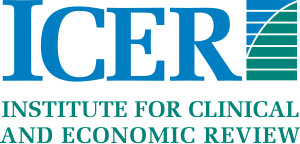— Independent appraisal committee found that evidence is adequate to demonstrate a net health benefit of tirzepatide added to background therapy in individuals with type 2 diabetes —
— Tirzepatide would achieve common thresholds for cost-effectiveness if priced between $5,500 – $5,700 per year —
— Payers should consider broadening criteria for coverage of both GLP-1 RAs and SGLT-2 inhibitors since these drugs may be considered first-line therapy in T2DM patients with cardiovascular or renal disease, and wider use should be encouraged in these specific populations —
BOSTON, February 15, 2022 – The Institute for Clinical and Economic Review (ICER) today released a Final Evidence Report assessing the comparative clinical effectiveness and value of tirzepatide (Mounjaro, Eli Lilly) for the treatment of type 2 diabetes (T2DM).
ICER’s report on these therapies was reviewed at the January 2022 public meeting of the New England CEPAC (New England CEPAC), one of ICER’s three independent evidence appraisal committees.
Downloads: Final Evidence Report | Report-at-a-Glance | Policy Recommendations
“Tirzepatide has a novel GIP and GLP-1 receptor agonist mechanism of action,” said Jon Campbell, PhD, MS, ICER’s Senior Vice President for Health Economics. “When compared to injectable semaglutide in one head-to-head trial, tirzepatide showed a greater decrease in HbA1c levels, weight, triglycerides, and blood pressure. However, studies of cardiovascular outcomes with tirzepatide have not been concluded, and therefore there is still uncertainty on its true comparative clinical effectiveness in relation to other available treatment options. Nonetheless, based on the available evidence, economic modeling can suggest a fair price range for tirzepatide, and the manufacturer and payers should work together to ensure that a fair price is set and linked to fair, evidence-based insurance coverage terms that do not pose unnecessary burdens to patients.”
Voting on Clinical Effectiveness and Contextual Considerations
A majority (13-0) found the evidence is adequate to demonstrate that a net health benefit when tirzepatide added to background therapy is compared to background therapy alone.
A slight majority (7-6) found that the evidence is not adequate to demonstrate a net health benefit when tirzepatide added to background therapy is compared to injectable semaglutide.
A majority (10-2, 1 abstention) found that the evidence is not adequate to demonstrate a net health benefit when tirzepatide added to background therapy is compared to empagliflozin.
During their deliberations, panel members also weighed the therapies’ other potential benefits, disadvantages, and contextual considerations. For tirzepatide, voting highlighted the following as particularly important for payers and other policymakers to note:
- Magnitude of the lifetime impact on individual patients of type 2 diabetes.
Voting on Long-Term Value for Money
Consistent with ICER’s process, the New England CEPAC did not vote on long-term value for money because the manufacturer has not yet announced a price for tirzepatide.
Tirzepatide is not yet approved by the FDA, and its manufacturers have not yet announced what the treatment’s US price would be if approved. ICER’s health-benefit price benchmark (HBPB) range for tirzepatide is between $5,500-$5,700 per year.
ICER’s HBPBs are price ranges suggesting the highest US price a manufacturer should charge for a treatment, based on the amount of improvement in overall health patients receive from that treatment, when a higher price would cause disproportionately greater losses in health among other patients in the health system due to rising overall costs of health care and health insurance. In short, it is the top price range at which a health system can reward innovation and better health for patients without doing more harm than good.
Key Policy Recommendations:
ICER’s independent assessment of value informs the critical decisions that stakeholders across the US health system need to make around pricing and coverage. Following the voting session, a policy roundtable of experts — including clinical experts, patient advocates, representatives from US payers, and the pharmaceutical manufacturer — convened to discuss the pricing implications and recommendations to ensure fair access. Key recommendations stemming from the roundtable discussion include:
- Payers should consider broadening criteria for coverage of both GLP-1 RAs and SGLT-2 inhibitors since, based on the most current clinical guidelines, these drugs may be considered first-line therapy in T2DM patients with cardiovascular or renal disease, and wider use should be encouraged in these specific populations.
- However, because tirzepatide does not yet have confirmed cardiovascular benefit, it is not unreasonable for payers to consider requiring HbA1c to be above 7% on a first-line treatment such as metformin before providing coverage of tirzepatide.
- All stakeholders have a responsibility to ensure that effective new treatment options for patients with T2DM are introduced in a way that will help reduce health inequities.
ICER’s detailed set of policy recommendations, including comprehensive considerations for establishing evidence-based prior authorization criteria, is available in the Final Evidence Report and in the standalone Policy Recommendations document.
About ICER
The Institute for Clinical and Economic Review (ICER) is an independent non-profit research institute that produces reports analyzing the evidence on the effectiveness and value of drugs and other medical services. ICER’s reports include evidence-based calculations of prices for new drugs that accurately reflect the degree of improvement expected in long-term patient outcomes, while also highlighting price levels that might contribute to unaffordable short-term cost growth for the overall health care system.
ICER’s reports incorporate extensive input from all stakeholders and are the subject of public hearings through three core programs: the California Technology Assessment Forum (CTAF), the Midwest Comparative Effectiveness Public Advisory Council (Midwest CEPAC), and the New England Comparative Effectiveness Public Advisory Council (New England CEPAC). These independent panels review ICER’s reports at public meetings to deliberate on the evidence and develop recommendations for how patients, clinicians, insurers, and policymakers can improve the quality and value of health care. For more information about ICER, please visit ICER’s website.
